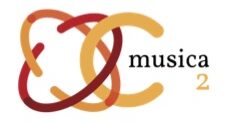PROJECTS BEYOND EARLY MUSIC
Cluster 6 – Challenges of musical heritage / Les défis du patrimoine musical (Biblissima+)
RicercarLab coordinates the cluster on music of the consortium Biblissima+, a multi-site digital infrastructure for research and service dedicated to the history of the transmission of ancient texts, from Antiquity to the Renaissance, in the West and in the East. Funded by the French Ministry of Research and Higher education (2021-2029), it aims to bring together digital resources and tools produced by academic research units (17 French institutions). It is organized in 7 clusters focusing on specific objects and/or technologies. The cluster on ancient music books and notation is coordinated by David Fiala (RicercarLab / CESR). Its objective is to have music metadata and data properly included in Biblissima+’s ecosystem. More specifically, it enhances the quality and richness of musical metadata and provides multimedia solutions for the accessibility to early music digital data, both for eyes and ears.
Click on the following links for news related to Cluster 6 :
Collection Zenodo
Journées inaugurales du cluster 6 Biblissima+ (2022)
Journées annuelles du cluster 6 Biblissima+ (2023)
Diaporama
Diaporama de la présentation du Cluster 6 lors des Journées Biblissima+ 2023
Diaporama de la présentation de l’équipe Portail lors des Journées Biblissima+ 2023


Biblissima+ bénéficie d’une aide de l’État gérée par l’ANR au titre du Programme d’investissements d’avenir intégré à France 2030, portant la référence ANR-21-ESRE-0005.
Consortium en musicologie numérique — MUSICA2
MUSICA2’s collaborative project builds on the accumulation of initiatives that have recently taken digital musicology in new directions. In 2017, the MUSICA(1) consortium reported on a number of advances. These included the development of tools, training courses and the dissemination of best practices. Since then, the musicological landscape has been enriched by existing resources and some new ones. Each of them raises questions about the nature of the metadata, of the research tools, of the presentation of the sources and even of the musical material itself.
Faced with the proliferation of these resources, the Consortium’s aim is to identify the invariants in the gestures and intellectual operations underlying the practices of working with sources through which music and its various contexts (historical, theoretical, social, aesthetic, philosophical, etc.) are presented. This direction, which is now the norm for data sharing, is more broadly in line with the FAIR data.
The challenges facing a consortium dealing with music are both classic and unique. In one way or another, as in the case of consortia based on human creations, the four cardinal points of reflection remain: (1) people, (2) productions and events, (3) places, and (4) sources and works. The basic referential framework remains the same, even when research focuses on the relationships between musical data. The users of music data, on the other hand, constitute communities with identities and behaviours that lie outside the usual contexts of research or higher education. The use of data and metadata takes on radically different forms, from enthusiasts of certain forms of pop music who identify their way of being with a particular type of music, to the community of medieval fiddlers, from music season programmers to amateur singing groups. The aim of MUSICA2 is to reconcile these repertoire and practice-specific uses with a global conception of what musical data and metadata are, so that they can finally be the beneficiaries of a dialogue that will bring scientific progress and cultural openness.
In line with the MUSICA2 objectives and deliverables, the consortium’s research is divided into three areas:
Steering Committee: Philippe Vendrix (coordinator), Achille Davy-Rigaux, Joann Élart and Kévin Roger
MUSICA2 is based at the Maison des Sciences de l’Homme Val de Loire.





